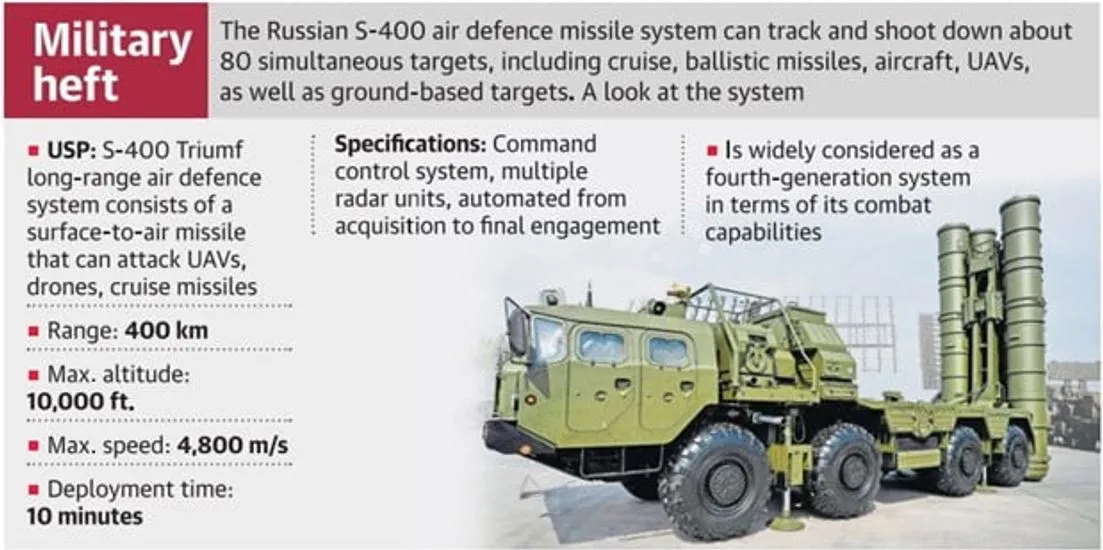

9th May 2025 (11 Topics)
Context
The Russian S-400 system and the Rafale Jets with SCALP Missiles — these twin weapons have proved to be the aces for India in Operation Sindoor and in the ongoing conflict with Pakistan.
About S-400 System
- The S-400 is a modern long-range surface-to-air missile (MLR SAM) system developed by Russia.
- It is the world’s premier long-range air defence weapon, capable of tracking and engaging multiple aerial targets within a range of up to 600 kilometre.
- It is widely regarded as one of the most advanced and formidable surface-to-air missile (SAM) systems in the world.
- Introduced into service in 2007, the S-400 is designed to provide a multi-layered air defence shield capable of intercepting a broad spectrum of aerial threats, including fighter jets, ballistic and cruise missiles, drones and stealth aircraft.

India's air and missile defence systems:
|
- Key Components and Capabilities
- It has three components: Missile launchers, a powerful radar and a command centre. It can hit aircraft, cruise missiles and even fast-moving intermediate range ballistic missiles.
- The system integrates several advanced radars and missile launchers coordinated by a command and control centre.
- Its multifunction radar suite includes the 92N2E Grave Stone tracking radar and the 96L6 Cheese Board acquisition radar, which provide 360-degree surveillance and can detect targets up to 600 kilometres away. The S-400 can simultaneously track up to 300 targets and engage up to 36 threats at once.
- The S-400 employs four types of missiles to create a layered defence:
- 40N6: A long-range missile with a reach of up to 400 km, capable of intercepting high-value targets at great distances.
- 48N6: A medium-range missile effective up to 250 km.
- 9M96E and 9M96E2: Short to medium-range missiles with ranges between 40 and 120 km, designed to strike fast-moving targets such as fighter jets and precision-guided munitions.
- These missiles can engage targets flying at speeds up to Mach 14 (approximately 17,000 km/h) and at altitudes ranging from 10 metres to 30 kilometres, including ballistic missiles at the edge of space.
- Inside the Indian Air Force, it is termed as the ‘Sudarshan Chakra’ which can detect, track, and destroy a wide variety of airborne threats — from fighter aircraft, to UAVs and ballistic missiles.
- India procured 36 Rafale fighter jets since 2020 from France in a government-to-government deal, which significantly enhanced the air prowess of India, giving it an edge over the US made F-16 fighter jets with Pakistan.
- India had to fight a lot of pressure exerted by the US when India decided to procure the S-400 defence system since 2018 in a USD 5 billion deal with Russia.
India vs Pakistan: Military Power Comparison (2025)
|
Category |
India |
Pakistan |
|
Global Rank |
4th (Global Firepower 2025) |
12th |
|
Military Budget (2024) |
USD 86 billion (2.3% of GDP) |
USD 10.2 billion (2.7% of GDP) |
|
Total Personnel |
5,137,550 personnel |
1,704,000 personnel |
|
Combat Aircraft |
2,229 |
1,399 |
|
Combat Tanks |
3,151 |
1,839 |
|
Naval Assets |
293 (over 6,100 km coastline) |
121 (1,046 km coastline) |
|
Nuclear Weapons |
Both possess; India has longer-range, more diversified delivery systems |
|
More Articles

